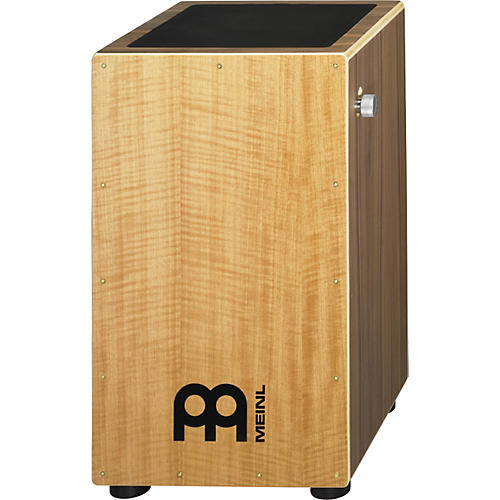Why Shop With Us?
Free Shipping
Free Standard Ground shipping (48 contiguous states, some overweight and Used/Vintage items excluded).
Orders placed before 3 p.m. ET usually ship the same business day.
Learn More2-Year Free Warranty on Guitars
Every guitar or bass you purchase from Musician's Friend (electric or acoustic, New or Open Box) includes two years of protection from manufacturer defects.
Contact Us for DetailsWe're Here for You
Our Gear Advisers are available to guide you through your entire shopping experience. Call or Chat for expert advice and to hear the latest deals.
Contact UsContact Us
Hablamos Español
866.226.2919
Hours:
MON - FRI 6 AM – 7 PM PT
SAT 6 AM – 6 PM PT
SUN 8 AM – 5 PM PT
Holiday Hours:
Thanksgiving: Closed
Christmas Eve Hours: 6 AM PT – 3 PM PT
Christmas Day: Closed
New Year’s Eve: 6 AM PT – 4 PM PT
New Year’s Day: Closed

Walnut Wood Snare Cajon with Anegre Frontplate
false falseWe're sorry-this item is unavailable.
Contact our experts for a recommendation of great alternatives. Call us at 800-449-9128.
Perfect for flamenco or world music.
The cajon is an authentic Afro-Cuban wooden box percussion instrument. Meinl cajons are completely handmade from start to finish. Drummers and percussionists appreciate the cajon for its diversity of sound. They're also perfect for unplugged gigs or sessions.
To equip a cajon with fully adjustable snare wires is an original Meinl innovation. The snares touch the frontplate from the inside and deliver the classical cajon sound, which is requisite in flamenco music. A knurled knob adjusts the amount of pressure used to press the snare wires against the frontplate. Rattling ranging from light and sensitive to very loud can be achieved through adjustment. The entire snare unit can even be turned off completely.
The cajon is one of today's most popular percussion instruments because it very easy to play, and provides a great feel and rhythmic foundation to any musical situation. It is fun to experiment with and is popular in literally every musical genre as it is often used during unplugged gigs or softer songs to replace an entire drum kit.
After just a little practice, basic beats and grooves can be achieved. It can be used by drummers as a substitute for their throne, playing on it with one hand, while the other hand keeps time on the ride or the hi-hat.
Many drummers also use the cajon during unplugged gigs, certain songs, or spontaneous sessions as its ability to emulate many sounds serves as an excellent substitute for a complete drum set.
Traditionally, cajon drums are played by sitting on the padded top of the box while slightly leaning backwards. The frontplate is struck with the bare hands. Various playing techniques help to create different sounds ranging from deep bass tones to cutting highs and slaps.
A nice effect can be achieved by sliding the foot up and down the frontplate when playing the cajon, in effect changing the pitch of its tone.
A unique and inspiring sound is achieved when playing the cajon's frontplate with a pair of brushes or rods.
The history of the cajon
The cajon, which is the Spanish word for box, has been part of Afro-Peruvian music since the 19th century. The instrument originated in colonial Peru, when the slaves, whose African drums had been forbidden by their masters, used wooden boxes intended to hold fruits or overturned drawers to play their rhythms on. Later the cajon was officially added to the instrumentation of the vals criollo, or "creole waltz." It is now a national emblem for Peruvians, and an indispensable part of any ensemble that performs the traditional folk music of Peru.
The cajon's later development can be clearly traced back to one man, the flamenco guitar player Paco de Lucia. In the early 1970s, the Spanish embassy in Lima, Peru hosted a party for Paco de Lucia, where they had a traditional Peruvian band perform utilizing the cajon. Flamenco music comprises many different rhythms which are normally played by the guitar player striking the body of the guitar. At that party, Paco de Lucia asked his former percussionist Ruben Danta to play the "Buleria" on the cajon, which is one of the rhythms used in flamenco. Consequently, Paco de Lucia took the cajon with him back to Spain. The short staccato sounds that can be played on the cajon make it perfect for flamenco music, because that sound naturally relates to the footwork and hand-claps ("palmas") used in Flamenco. Since the cajon's historic migration from Peru to Spain, its use has spread worldwide.
Features
- Frontplate: anegre wood
- Body: walnut wood
- Adjustable top corners
- Internal, adjustable Snare wires
- Padded sitting surface
Walnut Wood Snare Cajon with Anegre Frontplate Specifications:
19-1/2"H x 11-3/4"W x 11-3/4"L
- Free Standard Ground shipping (48 contiguous states, some overweight and Used/Vintage items excluded).
- Orders placed before 3 p.m. ET usually ship the same business day.
Every guitar or bass you purchase from Musician's Friend (electric or acoustic, New or Open Box) includes two years of protection from manufacturer defects.
Our Gear Advisers are available to guide you through your entire shopping experience. Call or Chat for expert advice and to hear the latest deals.

Musician's Friend Support






































































































































